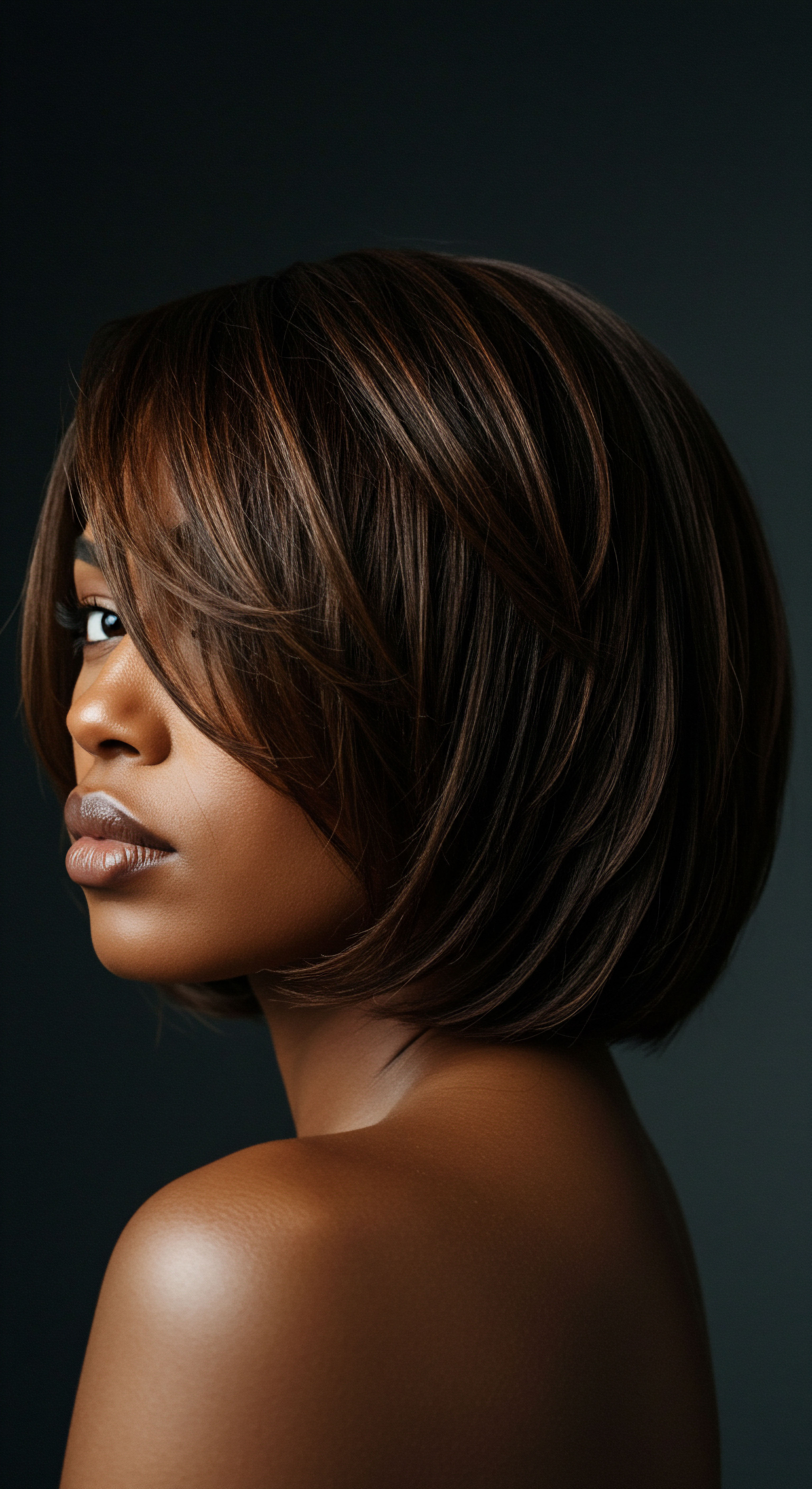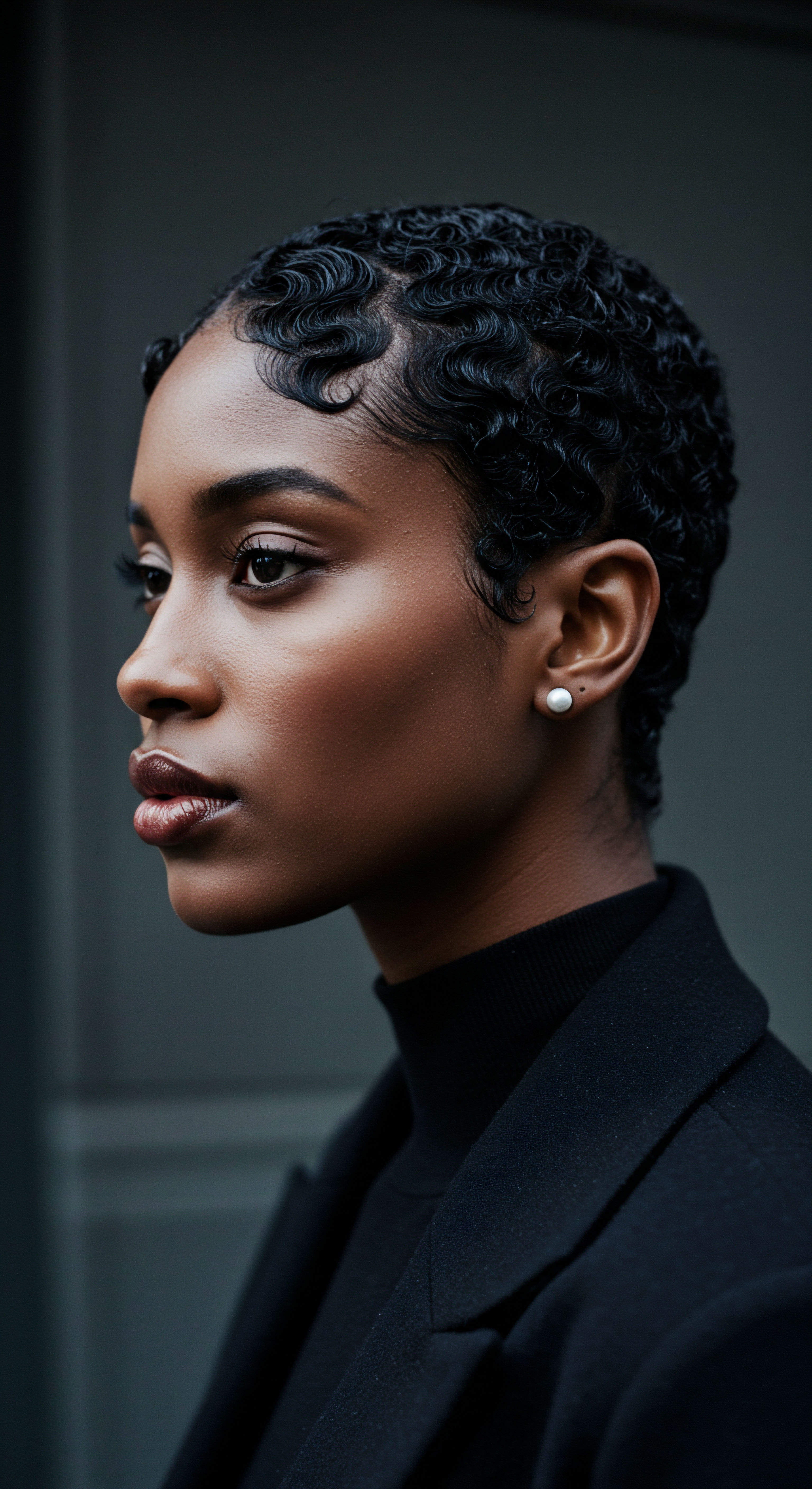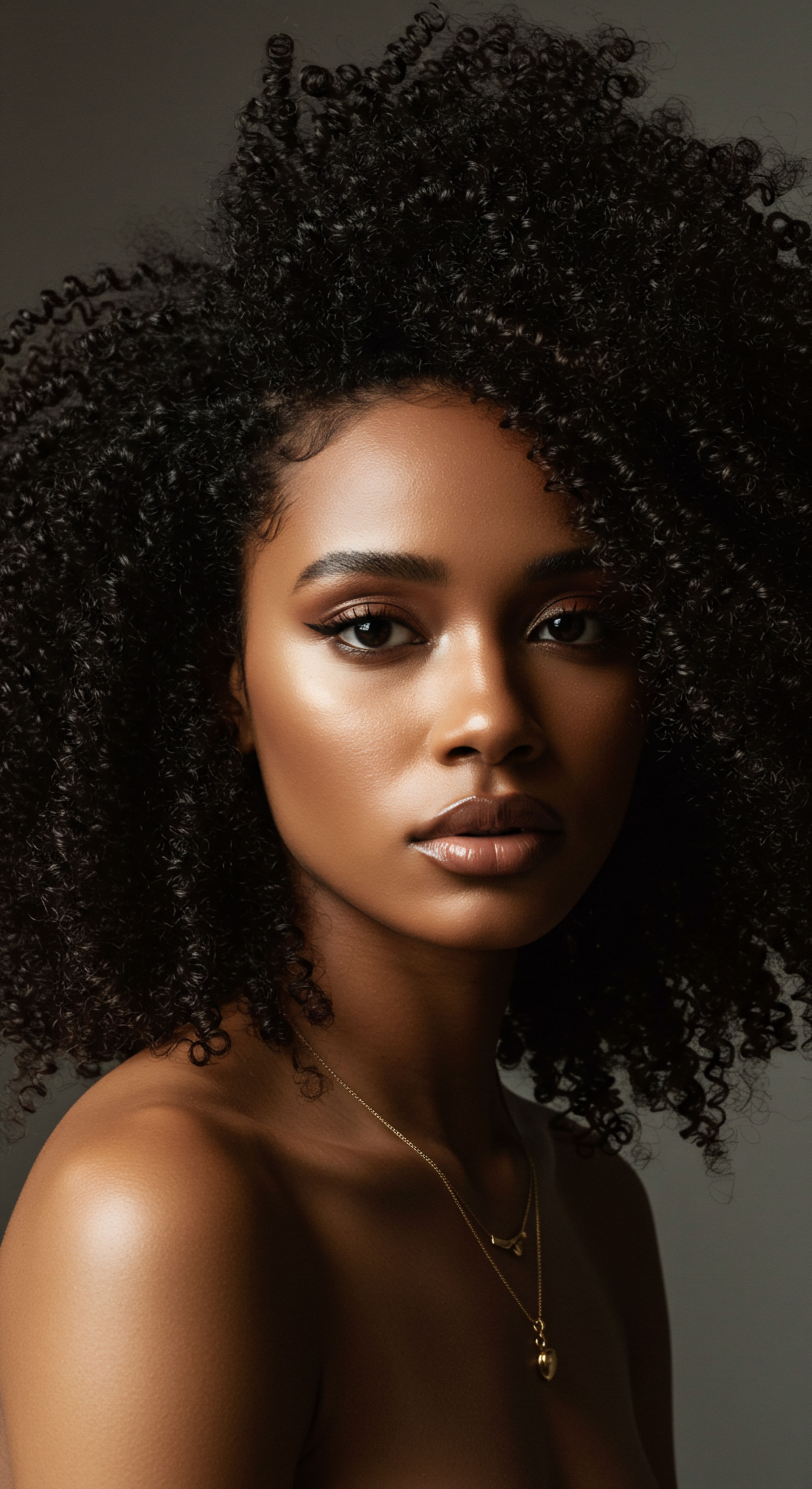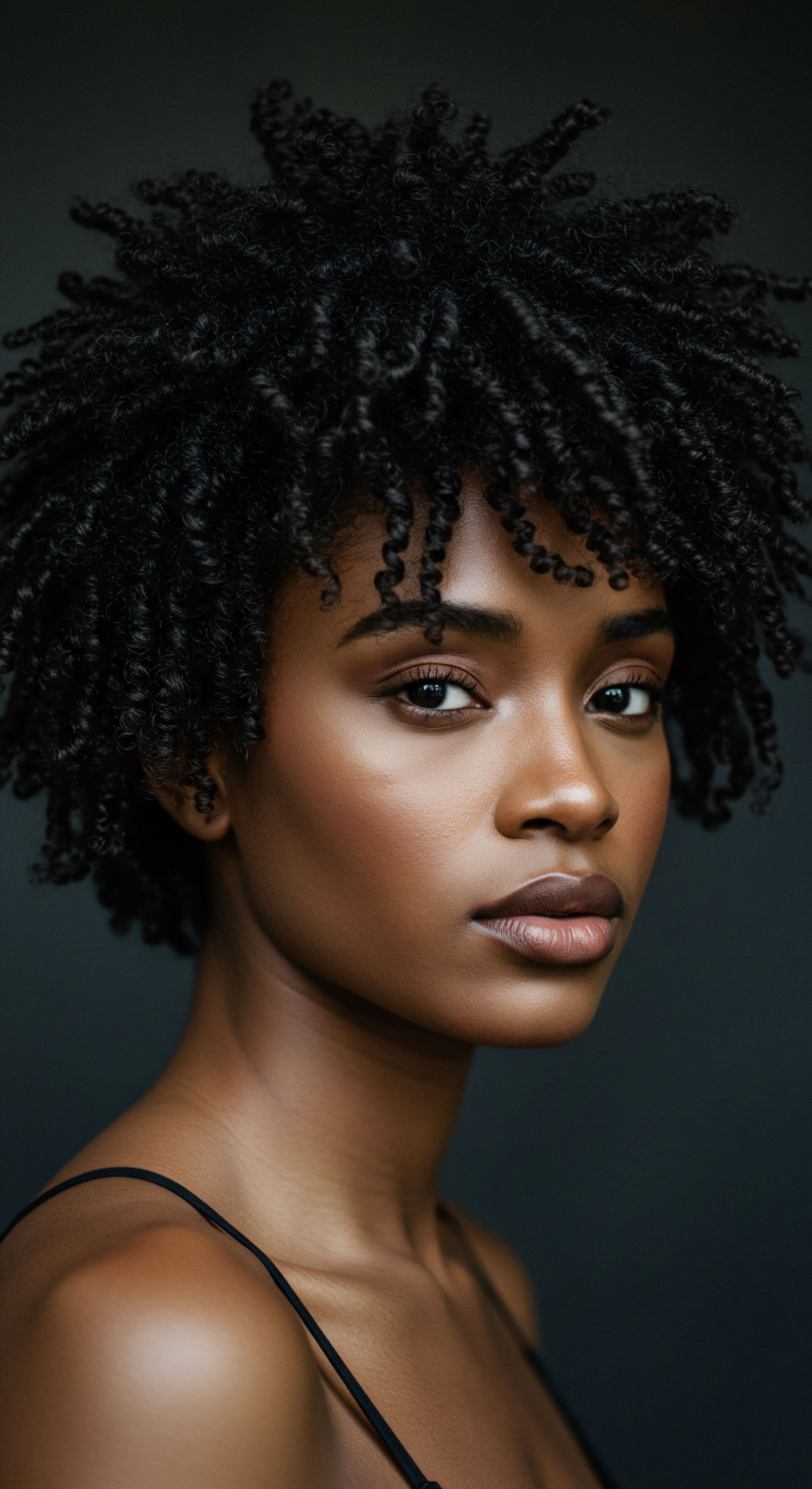
Roots
Consider the quiet strength held within each strand, a testament to resilience, a story whispered through generations. This is not merely about external appearance; it speaks to the very essence of well-being, an intrinsic connection between our inner rhythms and the vibrant life of our hair. We often seek remedies in jars and bottles, yet the deepest transformations frequently begin in the most unassuming spaces, particularly in the stillness of our slumber.
The profound relationship between restful nights and the suppleness of our hair, its ability to bend and return, its inherent spring, remains a subject of gentle contemplation and rigorous inquiry. To truly grasp how the quality of our sleep influences the spirited bounce and stretch of our textured hair, we must first settle into the foundational principles that govern hair health.
Hair, at its core, is a remarkable protein filament, primarily composed of Keratin. This fibrous protein, arranged in a complex structure, gives hair its strength and, crucially, its elasticity. Think of it as a microscopic spring, capable of extending and recoiling without breaking. This characteristic resilience is what allows textured hair, with its unique bends and coils, to withstand daily manipulation, environmental shifts, and styling.
The integrity of this keratin structure, along with the delicate balance of moisture within the hair shaft, dictates its capacity for flexibility. When these elements are compromised, hair can become brittle, prone to snapping, losing its vibrant spring.
Hair’s intrinsic resilience, its ability to stretch and return, is a direct reflection of its inner protein structure and hydration.

Hair Anatomy and Physiology Specific to Textured Hair
The anatomical nuances of textured hair strands are distinct, setting the stage for its unique needs and responses to internal and external conditions. Unlike straight hair, which typically possesses a circular cross-section, textured hair often presents an elliptical or flattened shape. This structural variation, coupled with a more uneven distribution of disulfide bonds along the hair shaft, creates the characteristic curls, coils, and kinks.
These inherent curves mean that textured hair strands have more points of vulnerability along their length, making them inherently more susceptible to mechanical stress and dryness. The cuticle, the outermost protective layer of the hair, tends to be more lifted in textured hair, which can lead to increased moisture loss and a greater susceptibility to damage.
Beneath the cuticle lies the cortex, the primary component responsible for hair’s strength and elasticity. The cortex comprises keratin bundles held together by a matrix of proteins and lipids. The health of this cortex, particularly its ability to retain moisture and maintain the integrity of its keratin bonds, directly correlates with hair’s pliability.
When the cortex is well-hydrated and its protein structure is robust, hair possesses a natural spring. Conversely, a dehydrated or structurally compromised cortex manifests as stiff, rigid strands that resist stretching and easily fracture.

Hair Growth Cycles and Influencing Factors
Our hair does not grow continuously; instead, it cycles through distinct phases ❉ anagen, catagen, and telogen. The Anagen Phase is the active growth period, where hair cells rapidly divide and keratin synthesis is at its peak. This phase can span several years, determining the ultimate length a strand can attain.
Following anagen, the brief Catagen Phase marks a transition, where hair growth ceases and the follicle shrinks. The final stage, the Telogen Phase, is a resting period, after which the old hair sheds to make way for new growth.
Numerous internal and external factors can influence the duration and health of these cycles. Nutritional deficiencies, systemic health conditions, hormonal shifts, and environmental aggressors all play a part. Significantly, the body’s reparative and regenerative processes are largely concentrated during sleep.
This nocturnal period is when our systems are optimized for cellular repair, hormone regulation, and the synthesis of vital proteins, including those essential for hair health. Disruptions to this nightly restoration can ripple through the hair growth cycle, affecting the very quality of the hair produced.
- Anagen Phase ❉ The active growth period where cells divide and keratin production peaks.
- Catagen Phase ❉ A short transition where growth halts and the follicle shrinks.
- Telogen Phase ❉ The resting phase, followed by shedding of old hair.

Ritual
As the day recedes and twilight settles, our bodies prepare for a nightly restoration, a quiet ritual that holds profound implications for the vibrancy of our hair. Many of us have observed the subtle shifts in our hair’s texture and resilience, sometimes attributing them to products or environmental factors. Yet, the unseen alchemy of sleep plays a significant, often underestimated, part in this daily unfolding.
The transition from waking hours to deep slumber is not merely a cessation of activity; it is an active period of repair and regeneration, where the body attends to its myriad needs, including the delicate structure of our hair. Understanding this nocturnal engagement allows us to appreciate the practical wisdom of restful nights and how these periods shape the very spring and flexibility of our strands.
The connection between adequate sleep and hair elasticity extends beyond simple observation; it is rooted in complex biological processes. During periods of profound rest, the body orchestrates a symphony of hormonal adjustments and cellular activities that directly influence the health of our hair. These processes are not always immediately visible, but their cumulative effect manifests in the hair’s resilience, its ability to stretch and recoil without breaking.

Hormonal Balance and Hair Resilience
Sleep acts as a meticulous regulator of our endocrine system. Key hormones vital for hair health, such as Growth Hormone and Melatonin, are predominantly released during specific sleep stages. Growth hormone plays a direct role in cellular regeneration, including the rapid division of cells within the hair follicle.
Melatonin, often recognized for its role in regulating sleep-wake cycles, also possesses properties that influence hair follicle activity and synchronize the hair growth cycle. When sleep is consistently insufficient or fragmented, the rhythmic production of these hormones can falter, potentially disrupting the anagen phase of hair growth and weakening the newly forming strands.
Conversely, inadequate sleep often triggers an elevation in Cortisol, often referred to as the stress hormone. While cortisol is a necessary component of our daily physiological responses, chronically elevated levels can become detrimental. Sustained high cortisol levels have been linked to a premature shift of hair follicles from the active growth phase into the resting phase, a condition sometimes referred to as telogen effluvium, leading to increased shedding. Beyond shedding, elevated cortisol can also indirectly compromise the very environment that supports hair elasticity.
Research indicates that high cortisol levels can reduce the synthesis and accelerate the degradation of vital skin elements, such as hyaluronan and proteoglycans, by approximately 40%. While these are components of the skin, their degradation affects the dermal environment surrounding the hair follicle, which is critical for its structural integrity and moisture retention, thereby indirectly influencing the health and suppleness of the hair shaft itself.

Cellular Repair and Protein Synthesis
Hair, composed primarily of keratin, relies heavily on efficient protein synthesis for its structural integrity. During deep sleep, the body prioritizes protein production and cellular repair across various tissues, including the active hair follicles. This period of rest allows for the robust synthesis of keratin, the fundamental building block of hair, and other structural proteins that contribute to the hair’s inherent flexibility.
A notable illustration of sleep’s impact on protein synthesis comes from a study examining men’s beard growth. This research observed that even a relatively short period of 48 hours of sleep deprivation resulted in a measurable reduction in protein synthesis and a 19% slowdown in beard growth. While this specific study focused on facial hair, it offers a compelling physiological insight into how systemic sleep disruption can impede the body’s capacity for protein creation, a process directly relevant to the continuous production of resilient hair strands. When the body cannot adequately synthesize the necessary proteins, the resulting hair may be weaker, less pliable, and more susceptible to damage.
Restful nights are the body’s dedicated hours for rebuilding and revitalizing, processes indispensable for resilient hair.

Circulation and Nutrient Delivery to the Scalp
The scalp, the foundation from which our hair grows, requires a steady supply of oxygen and nutrients to maintain healthy follicles. During the restorative phases of sleep, blood flow to the scalp generally increases, ensuring that these vital elements reach the hair follicles efficiently. This enhanced circulation is a quiet but powerful contributor to the overall health of the hair.
When sleep is disrupted, this optimal blood flow can be compromised, potentially limiting the delivery of essential nourishment to the hair follicles. A well-nourished follicle is better equipped to produce strong, elastic hair.

Mechanical Stress and Nighttime Protection
Beyond the internal biological processes, the physical interactions during sleep also hold significance for hair elasticity. Tossing and turning on rough pillowcases, such as cotton, can create considerable friction against the hair strands. This constant rubbing can lead to mechanical abrasion, weakening the hair cuticle, and ultimately resulting in breakage and a loss of elasticity. Textured hair, with its naturally raised cuticle and inherent bends, is particularly vulnerable to this type of friction.
To mitigate this, traditional practices and modern recommendations alike point towards protective measures. Using a Silk or Satin Pillowcase, or wrapping hair in a scarf or bonnet made of similar smooth materials, significantly reduces friction. These materials allow hair to glide rather than snag, preserving the cuticle’s integrity and minimizing mechanical stress. This simple ritual can make a discernible difference in preventing dryness, frizz, and the loss of that desirable hair spring.
| Factor Hormone Regulation |
| Impact of Quality Sleep Optimizes growth hormone and melatonin release. |
| Consequence of Poor Sleep Elevates cortisol, disrupts growth hormones. |
| Factor Protein Synthesis |
| Impact of Quality Sleep Supports robust keratin production for strength. |
| Consequence of Poor Sleep Reduces protein creation, leading to weaker hair. |
| Factor Blood Circulation |
| Impact of Quality Sleep Enhances nutrient and oxygen delivery to follicles. |
| Consequence of Poor Sleep Limits nourishment, impeding follicle health. |
| Factor Mechanical Stress |
| Impact of Quality Sleep Reduces friction with protective surfaces. |
| Consequence of Poor Sleep Increases cuticle damage and breakage. |
| Factor A well-rested body supports comprehensive hair health. |

Relay
The delicate dance of hair elasticity, its ability to yield and recover, is a nuanced conversation between internal biological imperatives and the quiet influence of our nocturnal existence. How deeply does the quality of our sleep truly reach into the very fiber of our strands, shaping their resilience and spirited recoil? This inquiry invites us to move beyond the superficial, to peer into the intricate interplay of cellular mechanisms, hormonal dialogues, and even the subtle cultural practices that underscore the significance of rest for our hair’s well-being. The connection is not a simple linear cause and effect, but rather a complex system where every disruption to our rest sends ripples through the biological architecture that maintains hair’s pliable strength.
The scientific literature offers compelling perspectives on the systemic consequences of compromised sleep, demonstrating how these impacts reverberate throughout the body, ultimately influencing the very structural integrity of hair. Our understanding of hair elasticity must extend beyond the mere presence of protein; it encompasses the dynamic environment in which these proteins are synthesized and maintained.

What Biological Mechanisms Underpin Hair Elasticity’s Link to Sleep?
At the cellular level, the production of hair’s primary protein, keratin, is a highly regulated process. This production is intimately connected to the body’s overall metabolic and regenerative state, which is profoundly influenced by sleep architecture. During the deeper stages of non-REM sleep, the body undergoes significant protein synthesis and cellular repair. This period is critical for the continuous regeneration of hair follicle cells, which are among the most rapidly dividing cells in the human body.
When these processes are interrupted by insufficient or poor-quality sleep, the raw materials and energy required for robust keratin production may be suboptimal. The resulting keratin may be less organized, less cross-linked, or simply less abundant, leading to strands that are inherently weaker and possess diminished elasticity.
Consider also the role of growth factors and cytokines. These signaling molecules, many of which exhibit circadian rhythms influenced by sleep, play a crucial role in regulating the hair growth cycle and supporting the health of the dermal papilla, the specialized cells at the base of the hair follicle that direct hair growth. A disrupted sleep pattern can dysregulate the release of these factors, potentially shortening the anagen (growth) phase and pushing more hairs into the telogen (resting) phase prematurely. Hair produced under such conditions may not only shed sooner but also be finer and less elastic from its inception.
Beyond direct protein synthesis, the integrity of the hair follicle itself, and the surrounding scalp tissue, contributes significantly to hair elasticity. The dermal environment, rich in collagen and other extracellular matrix components, provides structural support for the growing hair shaft. While direct studies on sleep deprivation and hair follicle collagen synthesis are still developing, research on skin health provides an interesting parallel. A study published in MDPI investigated the effects of sleep deprivation on skin barrier function and dermal collagen synthesis in female mice.
It found that sleep deprivation disrupted the circadian rhythm of estrogen, particularly estradiol, which in turn impaired skin barrier functionality and decreased dermal collagen synthesis. Crucially, topical taurine supplementation was shown to restore collagen production in these sleep-deprived mice. This suggests a broader principle ❉ systemic disruptions from poor sleep can indeed affect the synthesis of structural proteins that support healthy integumentary structures, including those indirectly vital for hair’s resilience.
The nocturnal hours serve as a vital crucible where the very building blocks of hair’s resilience are forged.

How Does Stress Mediated by Sleep Disruptions Influence Hair’s Pliability?
The interplay between sleep, stress, and hair elasticity is particularly complex. Chronic sleep deprivation elevates systemic cortisol levels, as confirmed by numerous studies. While the direct impact of cortisol on hair elasticity specifically is a less explored avenue than its link to hair loss, the mechanisms through which it affects the hair follicle and its environment are pertinent. High cortisol has been shown to reduce the synthesis and accelerate the degradation of hyaluronan and proteoglycans in the skin by approximately 40%.
These molecules are critical for maintaining skin hydration and structural integrity. Given that the hair follicle is embedded within the skin, a compromised dermal environment—one with reduced hydration and structural support due to proteoglycan degradation—could indirectly affect the quality of the hair produced. Hair growing from a less optimally hydrated and supported follicle might inherently possess less flexibility and be more prone to becoming dry and brittle, thus losing its natural spring.
Consider the cumulative effect ❉ a body under chronic stress from poor sleep is in a perpetual state of alert. This physiological state diverts resources from non-essential functions, such as optimal hair production and maintenance, towards immediate survival responses. The result is often hair that appears dull, feels coarse, and lacks its characteristic elasticity, not due to a single, direct insult, but from a cascade of systemic compromises.

Cultural Dimensions of Sleep and Hair Wellness
Across diverse cultures, the practice of caring for hair often extends into the nighttime, reflecting an intuitive understanding of hair’s vulnerability during sleep. These rituals, passed down through generations, often incorporate protective styles and materials designed to safeguard strands from the mechanical stresses of tossing and turning.
- Protective Head Wraps ❉ In many African and diasporic traditions, wrapping hair in silk or satin scarves, bonnets, or specialized head wraps before bed is a long-standing practice. This is not merely a stylistic choice; it serves to reduce friction against coarse bedding, prevent tangling, and preserve moisture within the hair shaft. This practice directly mitigates the physical stressors that can compromise hair elasticity.
- Loose Braids and Twists ❉ Styling hair in loose braids, twists, or pineapple buns before sleep is a common method to minimize knots and breakage. By containing the hair, these styles prevent individual strands from rubbing against each other or the pillow, thereby preserving the cuticle and the hair’s inherent spring.
- Herbal Infusions and Oils ❉ Some traditions incorporate nighttime application of nourishing oils or herbal infusions, sometimes covered with a protective fabric. While these primarily target scalp health and moisture, the act of applying them gently and then protecting the hair further supports the overall integrity that contributes to elasticity.
These practices, rooted in ancestral knowledge, intuitively address the very issues that modern science now elucidates ❉ the need to protect hair from friction, retain moisture, and allow the body’s natural regenerative processes to proceed undisturbed. The resilience and beauty of textured hair, often celebrated as a crown, are thus not solely a matter of genetics or product use, but also a testament to the consistent, gentle care provided during the quiet hours of rest. The collective wisdom embedded in these nighttime hair rituals underscores a profound understanding of how sleep quality, even through its indirect mechanical and environmental impacts, contributes to the enduring spring and vibrancy of our hair.
| Sleep Quality Metric Consistent Sleep Duration |
| Hair Health Outcome Stable Hair Growth Cycles |
| Associated Biological Process Hormonal regulation, cell division timing |
| Sleep Quality Metric Deep Sleep Phases |
| Hair Health Outcome Enhanced Protein Synthesis |
| Associated Biological Process Keratin production, cellular repair |
| Sleep Quality Metric Reduced Sleep Latency |
| Hair Health Outcome Lower Cortisol Levels |
| Associated Biological Process Reduced stress-induced follicle disruption |
| Sleep Quality Metric Minimized Nighttime Friction |
| Hair Health Outcome Preserved Hair Cuticle Integrity |
| Associated Biological Process Prevention of mechanical damage, moisture retention |
| Sleep Quality Metric Optimizing sleep offers multifaceted benefits for hair vitality. |

Reflection
The journey into how sleep quality shapes hair elasticity reveals a truth more intricate than simple observation might suggest. Our hair, a vibrant expression of our being, is intimately connected to the quiet, restorative processes that unfold as we surrender to the night. It reminds us that true well-being is a symphony of interconnected systems, where the quality of our rest reverberates through every strand, influencing its strength, its moisture, and its inherent spring. This understanding invites us to approach our nighttime rituals not as mere routines, but as sacred opportunities to nourish our hair from within, honoring its delicate needs and celebrating its natural resilience.

References
- Clinikally. (2024, July 16). Impact of Sleep Deprivation on Hair Health.
- MONPURE. (2024, March 15). Hair Loss ❉ Is Lack of Sleep Stunting Growth?
- The Hair Fuel. (2024, October 4). Does Sleep Help Hair Growth? Your Guide to Hair Health and Sleep.
- Ms.Medicine. (2025, February 19). Beauty Sleep Guide ❉ How Sleep Affects Skin & Hair Health.
- Hair Doctors. (2025, April 2). Can Lack of Sleep Make You Lose Hair? Uncovering the Connection.
- Kaya Skin Clinic. (2025, April 25). Traction Alopecia ❉ Causes, Symptoms, & Effective Treatment.
- Journal of Drugs in Dermatology. (2016). The Impact of Cortisol on Hair Loss and Skin Conditions ❉ What Health Practitioners Need to Know.
- NeuroLaunch.com. (2024, August 26). Sleep and Hair Growth ❉ The Surprising Connection.
- Hair Replacement. (n.d.). Can The Way You Sleep Cause Hair Loss?
- Hairprint Asia. (2020, February 20). How Important Is Sleep For Hair Growth.
- MDPI. (2022). Taurine Prevents Impairments in Skin Barrier Function and Dermal Collagen Synthesis Triggered by Sleep Deprivation-Induced Estrogen Circadian Rhythm Disruption.
- NeuroLaunch.com. (2024, August 26). Sleep and Hair Growth ❉ The Surprising Connection.
- University of Utah Health. (2023, September 12). Is It Bad to Sleep with Wet Hair?
- Journal of Drugs in Dermatology. (2016). Stress and the Hair Growth Cycle ❉ Cortisol-Induced.
- Dr. Terziler. (n.d.). Does Sleeping on Only One Side Cause Hair Loss?
- Journal of Drugs in Dermatology. (2016). Stress and the Hair Growth Cycle ❉ Cortisol-Induced Hair Growth Disruption.
- ResearchGate. (2016). (PDF) Stress and the Hair Growth Cycle ❉ Cortisol-Induced Hair Growth Disruption.
- ResearchGate. (2025, April 27). AP collagen peptides improve hair growth and quality by promoting human hair cell proliferation and keratin synthesis.
- PubMed. (2024, October 19). Psychological stress impact neurotrophic factor levels in patients with androgenetic alopecia and correlated with disease progression.
- Healthline. (2021, March 1). Too Much Protein in Hair ❉ Causes, Effects, and More.
- MDPI. (2022). Sleep Quality ❉ A Narrative Review on Nutrition, Stimulants, and Physical Activity as Important Factors.
- ResearchGate. (2023, July 17). Association of hair glucocorticoid levels with sleep quality indicators ❉ a pilot study in apparently healthy perimenopausal and menopausal women.
- Frontiers in Behavioral Neuroscience. (2014). Sleep and protein synthesis-dependent synaptic plasticity ❉ impacts of sleep loss and stress.